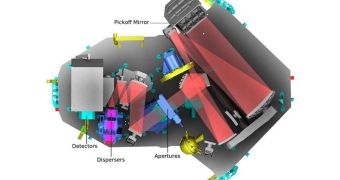Officials at the NASA Goddard Space Flight Center (GSFC) announce that the Near-Infrared Spectrometer (NIRSpec), one of the five critical scientific instruments that will go on the James Webb Space Telescope, arrived at the Center's Greenbelt, Maryland headquarters on September 20.
The delicate instrument was assembled at EADS Astrium's facility in Munich, Germany. The instrument was built by the European Space Agency (ESA) through its Space Research and Technology Center (ESTEC), Noordwijk, the Netherlands.
Astrium contracted Oberkochen, Germany-based company Carl Zeiss Optronics GmbH to create the complex micro-shutter mechanisms (and related optical elements) that allow NIRSpec to conduct simultaneous observations of hundreds of targets in its field of view.
Upon completion, the instrument was transported from Germany to the Thurgood Marshall BWI airport, in Baltimore, Maryland, aboard a special transport airplane of Russian design. A truck then moved JWST's SuperEye to the GSFC, which houses the world's largest clean room.
The reason NIRSpec is called the SuperEye is that it will be responsible for conducting infrared analysis of light coming from very distant galaxies, stars and planets. The data thus obtained will allow astronomers to determine the physical and chemical traits of these objects.
Scientists at NASA say that James Webb will be able to observe extremely far in the history of the Universe, up to a point where the Cosmos was just a few hundred million years old. The capabilities of this telescope will be far beyond those of NASA's current flagship observatory, Hubble.
With the arrival of NIRSpec, GSFC engineers now have James Webb's entire suite of scientific instruments at their disposal, and can affix them to the Integrated Science Instrument Module (ISM). Two of the other instruments have already been integrated, and are currently undergoing an early round of cryogenic tests.
“"NIRSpec's delivery from Europe to Goddard is an amazing international accomplishment,” says the Webb system integration and test manager at ESA, Maurice te Plate. The expert is also the manager of the Mir IR Instrument (MIRI) at GSFC.

 14 DAY TRIAL //
14 DAY TRIAL //